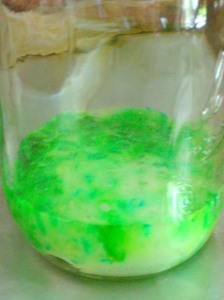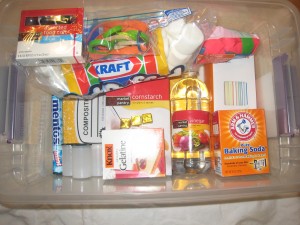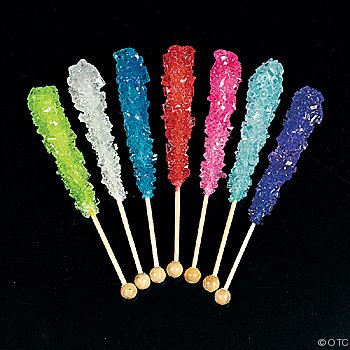1) The Invincible Soap Bubble

This new form of bubble is not only exciting to make but can be used to answer a mind-boggling question . Why do bubbles have color? Place different objects around the bubble and record on a sheet of paper the change in color that occurs. You can then compare the recordings and come up with a logical answer using your data.
2) Make Your Own Thermometer

Learning how a thermometer works can be tricky at first. This experiment lets children understand the simple concept of knowing when the red rises, it is becoming warmer outside. The water will raise in the straw as the temperature raises, and will contract when it becomes cooler.
3.) How An Octopus Protects Itself

Animals protect themselves in many different ways. An octopus releases a black ink that allows itself to escape from prey without being seen. Through this experiment the child will explore first hand exactly how this mechanism works.
4) Rainbow Density
Using the layering of simple household items like dish soap, water, olive oil, rubbing alcohol, corn starch and food coloring, children will get to explore the density of liquids through this hands on experiment. Instead of explaining the definition of density to a child, show them using this educational AND fun experiment!
5)Alka Seltzer Rocket

Explore the force that simple household items can make with this chemical reaction. The built up pressure from the mixture of water and alka seltzer will send this rocket soaring!
6) Dissolving Packing Peanuts

Using packing peanuts and different solvent/liquids explore the difference in how fast they dissolve into each one. Have children first make a prediction or hypothesis, then have them explain their reasoning behind these predictions. See if your hypothesis was correct!
7) Tornado in a Bottle

All you need for this experiment is a bottle, water and dish soap. How much simpler could it get? Use this visual to allow children to see what a tornado truly looks like up close and personal. (TIP: Food coloring makes everything more exciting!)
8.) Chemistry and Fizzing Magic Potions

Let children explore the reaction of baking soda and vinegar, while also enhancing their fine motor skills and hand eye coordination. For younger children, the use of food coloring can be used to help with color recognition as well.
9) Rocky Candy
Explore a super saturated solution with this experiment. You will need a glass of water, sugar, a clothespin and a stick. Children will get to watch the rock candy grow throughout the week. Having a small
recording booklet to draw or write the changes
10) Soapy Clouds
Your child will love using this experiment to help them understand clouds better. Just simply place a bar of ivory soap in the microwave for two minutes and watch it work its magic. Compare this to the three types of clouds and have children choose which cloud type it is and why.
10 Science Blogs/ Websites
1) Science Is Super Fun
Visit this blog to help you choose some hands on, interactive science experiments that you will enjoy just as much as your children. Explore the variety of easy activities that can be linked to science.
2) ZOOMsci from PBSkids
Zoom is an educational television show on PBS with many educational benefits. Explore this website to find science experiments and activities that are demonstrated on the show.
3) Science Sparks
Is it magic or is it science? Children will get to experience the magic of science and its many wonders. How do you stick a toothpick in a balloon without it popping? How can you change the color or flowers? How do you turn milk into glue? These are just a few mind boggling experiments that children can do and learn how science fits into the mix.
4) Science Matters

This blog is filled with life science activities for children to do with the help of a parent or adult. Learn about the states of matter, earthquakes, diffusion and much more through these step by step experiments.
5) The Science Mommy

This is a fun kitchen counter exploration of experiments using everyday items in the kitchen. Kid Scientists can explore on their own, while mom's working on something else.
6) Science For Kids
This blog lists many experiments that have been tested by a real teacher. Step by step directions to follow are listed with each activity and also explains the way that each activity can connect to science.
7)What the Teacher Wants

This blog includes many activities that can be done in the classroom, which also means they are safe to do at your house. There are 3 fun experiments that allow children to be hands on while also connecting what they are doing with science.
8)The Tinker Lab

Round up your old household items for the activities in this blog. It list ways that you can do experiments with everyday items and also relate them to science and inquiry.
9)Kitchen Pantry Scientist

The website provides reasoning why making a homemade science kit for your child can be beneficial. It then provides activities that children can use this kit for to do science experiments and discovering things on their own.
10) Inspirational Laboratories

The blog has ten fun and simple science ideas and activities to keep your child learning about science while also being hands on and involved. The activities range in age and cover a wide variety of topics.
10 Children's Books For Science

The book is about a boy who wants to make pancakes for his mom and dad. The boys head out to the store to get what he needs, and as he shops he discovers where the food he needs comes from. Teach your children how to meausre and cook with this exciting book!

This book illistrastes the size of the bites of 11 different animals from around the world. These anilals range from griaffes to butterflys. This book also shows the different eating habbits of each animal with illistrations that put the words into perspective for children. The book can be used to show and explore the different eating habbits of animals around the world.

This book is about sea creatures for each letter of the alphabet. Each page explains a selected species with a full-color illustration and a paragraph of facts, surrounded by extra creatures and vocabulary. It reaches a large age range because the large text is for young readers, while smaller text is for you or more advanced children. Read this book to help your children learn about the animals of the sea.

Have you ever wondered what makes you sneeze when you're in a dusty room? Or shiver when you get out of the bathtub? Or yawn when you're tired? All of these actions are reflexes. Your body makes them happen even though you don't tell it to.
Budding young scientists will be amazed as Melvin Berger and Paul Meisel reveal the mysteries behind the reflexes that happen in our bodies every day and offer fun-filled experiments to try on family and friends
http://www.harpercollinschildrens.com/books/Why-Sneeze-Shiver-Hiccup-Yawn/

This book provides experiements for children. The experiments explore various subjects: bubbles, the surface tension of a drop of water, snowflakes, steam. Instructions include fascinating tips on how to catch a snowflake on a mirror, and how to find a rainbow in dew-laden spider webs

This book is a great way to introduce Albert Einstein to your child and also presents images and definitions of various objects you might use as a scientist. The back of the book includes a short section for parents, including
some facts about Einstein's life, and some questions you can ask your
children.

This book explains and helps children understand how every link in a food chain is important
because each living thing depends on others for survival. Clear, simple
drawings match up to the the clear, simple text for every age to understand. This science book allows children to think about the web of life on Earth.

This book describes and explores an imaginary journey through the night sky, from joining Orion
on a hunt to hitching up the North Star for a ride. It includes facts
about astronomy, the solar system, and constellations, and would be a great starter book to introducing the solar system.

Old Bear lumbers to his cave to hibernate till spring. In his dreams, he
is a cub again, exploring the seasons—summer, fall, winter, and spring.
When he finally awakes, Old Bear is so happy to find the outside world
waiting for him, just as beautiful as in his dreams. http://www.kevinhenkes.com/book/old-bear/
This would be a good book to help children learn about the different seasons.

A grandfather and his
small grandchild are walking together at the end of the day--a perfect
time to wonder about all manner of things: Where do streams come from?
Where do they go? How far can birds fly?
http://www.goodreads.com/book/show/7610794-where-does-the-sky-end-grandpa
Beach Themed Science Box

This experiement can be used when talking about things that sink and float in the ocean. I would place some shells, plastic cap, and rocks. Children could shake the bottle and then use a recording sheet to record which items float and which items sink.


Having a sandbox in the classroom for children to build their own sandbox would be a great follow up activity to go along with the book below about building sand castles. Children could then measure and record parts of their sand castle on a chart. This would let children practice their measuring skills.

One Saturday at the beach, Laura, Juan, and Sarah decide to have a sand
castle contest. As the tide rises, the walls get longer, the towers get
taller, and the moats get deeper. The friends measure their sand
castles with spoons, shovels, and bare feet
until Larry the lifeguard and his tape measure surprise them all.








